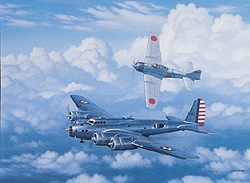|
|
| Birth of A Legend |
|
 |

|
 |
|
|
| DESCRIPTION |
 |
| 16 x 11.5 Inch Collector Size Unframed Lithograph $40.00
Colin P. Kelly America's first hero of WW II was born in Florida in 1915. He was accepted to the U.S. Military Academy at West Point and following graduation Kelly married the former Marian Wick. Kelly received his primary flight instruction at Randolph Field in San Antonio and after earning his wings he moved across town to Kelly Field for advanced pilot training. Unlike many would-be fighter pilots Kelly was not disappointed with being assigned as a bomber pilot. Kelly received a letter of commendation from The Secretary of War when he crash landed a Northrop A-17A he was ferrying to Mitchel field in a vacant street in Brooklyn. In September of 1940 Kelly was promoted to Captain and was assigned to the 42nd Bomb Squadron as commander of a B-17. Kelly trained in Hawaii and was later made Operations Officer for the 14th Bomb Squadron. In September of 1941 Kelly and his crew flew from Hawaii to Clark Field in the Philippines. The B-17s were an important addition to the woefully inadequate and obsolete air forces which America had in the Philippines. The Japanese Imperial forces attacked the Philippines only hours following the attack on Pearl Harbor. Mitsubishi Zero fighters flying to maximize their range were able to accompany Japanese bombers from bases in Formosa. The initial attack on Clark Field damaged or destroyed many American aircraft. Kelly's squadron had been moved south to another field and had escaped damage. On December 10 Kelly's squadron was ordered to fly north to Clark Field where they would refuel and arm their aircraft for attacks on the Japanese invasion fleet. Kelly's regular B-17D was out of service so his crew was assigned a B-17C. At Clark Field three 600-pound armor piercing bombs were loaded on Kelly's B-17 when an air raid hastened their departure. Kelly flew northward to the northern most tip of the island of Luzon. Kelly spotted a number of Japanese ships which were supporting an amphibious landing. The young Captain dropped his three bombs hoping to destroy the largest of the Japanese ships. One bomb struck the vessel igniting a tremendous blaze. On returning to Clark Field the B-17 was attacked by a number of Japanese fighters including a Zero flown by Saburo Sakai. Sakai would become the highest scoring Japanese ace to survive the War with 64 victories. Amazed by the speed of the Flying Fortress the Zeros needed full throttle to make passes at the B-17. Kelly's B-17 was eventually hit and set afire. Captain Kelly ordered his crew to abandon ship. Kelly remained with the aircraft and he did not survive the crash landing. With America desperate for any good news on the war front and with Army brass in the Philippines anxious to claim some positive results Colin Kelly's exploits became exaggerated in many news accounts. By the time the story was publicized stateside many believed he had dived his B-17 down the funnel of a Japanese battleship. While Kelly was indeed an American hero the unfortunate gross exaggeration of his exploits should not tarnish the fact that Kelly like many that would follow him in the years ahead had made the ultimate sacrifice for his country in the line of duty. |
|


|